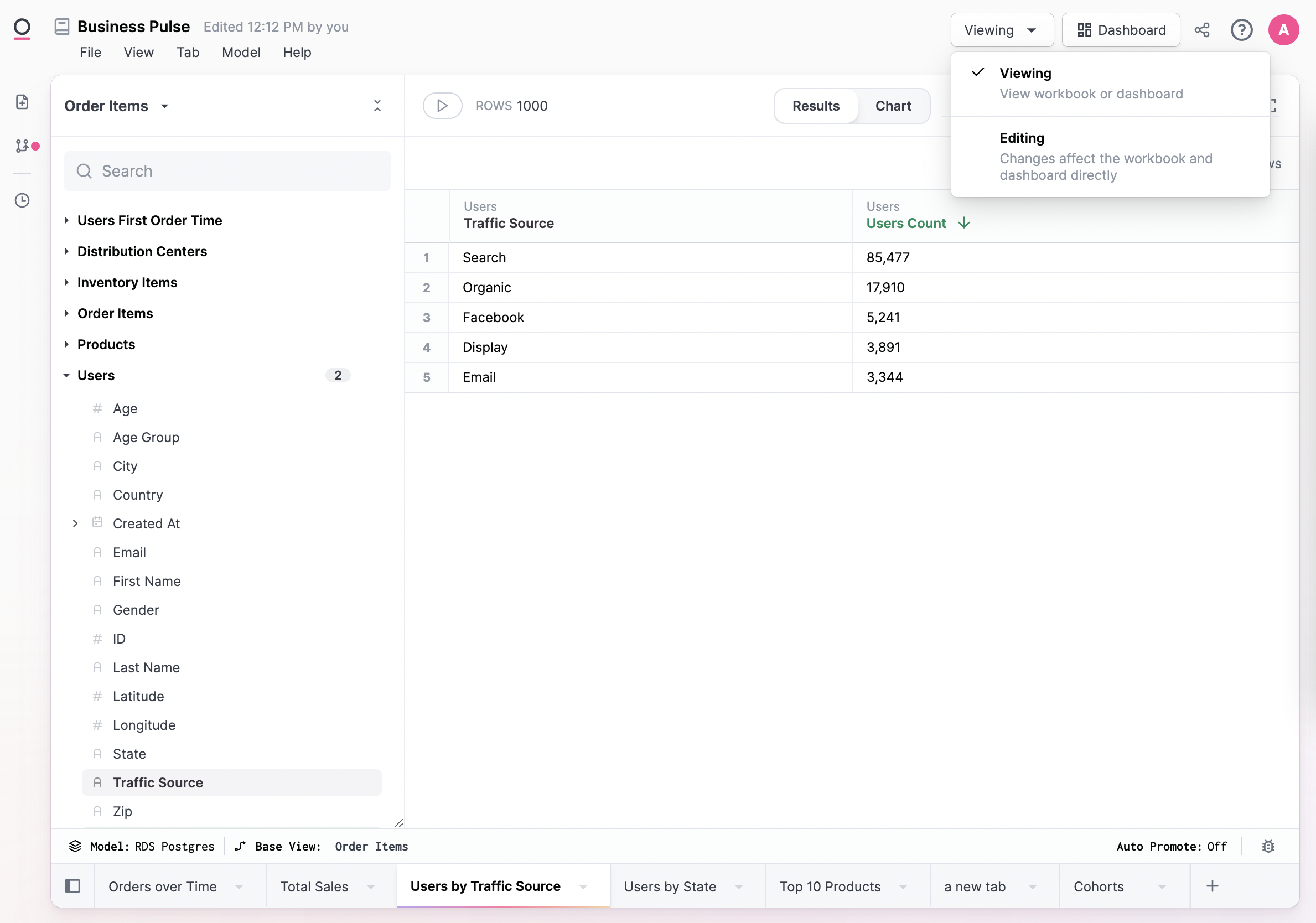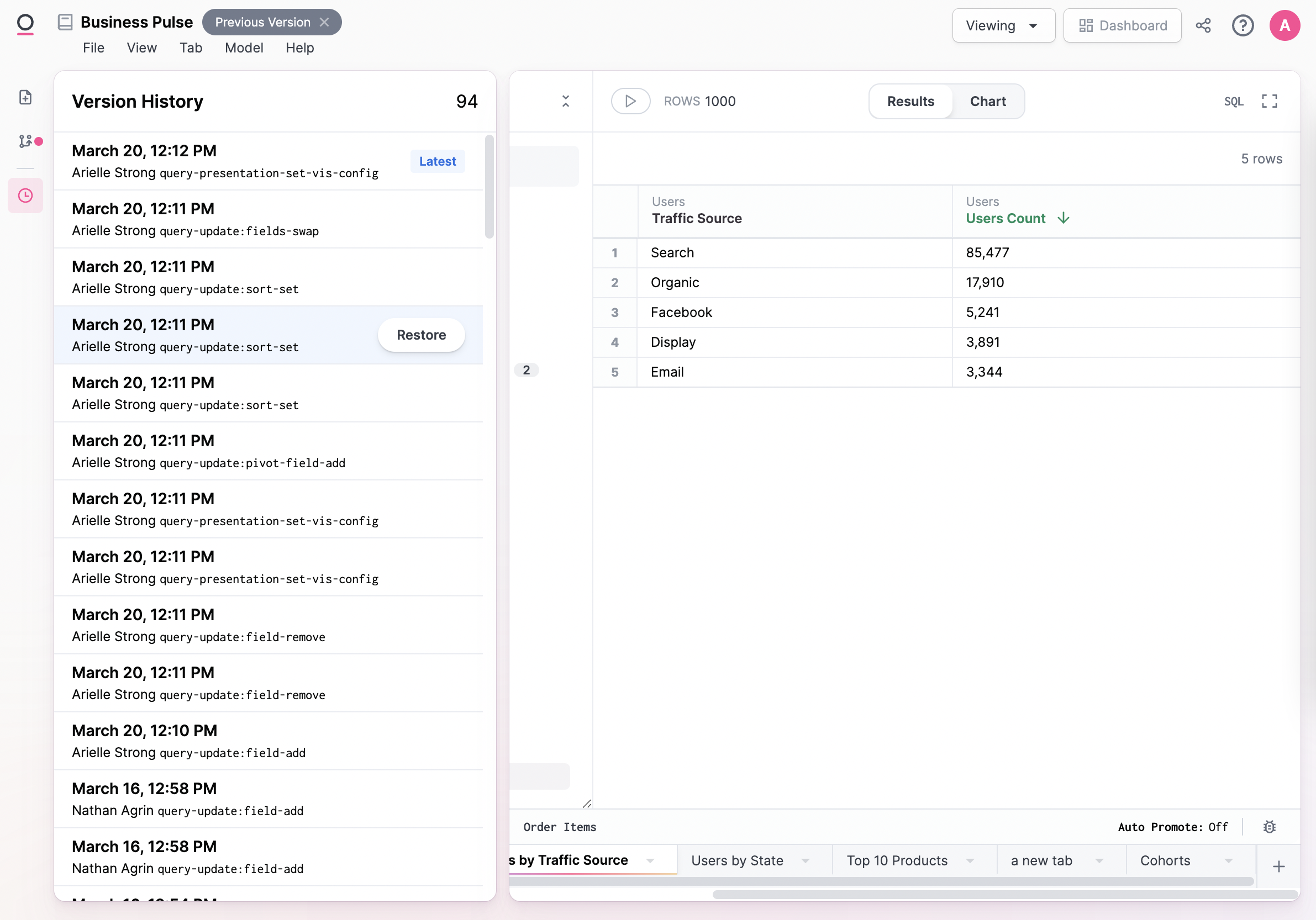Build analyses in workbooks
Omni's workbook UI is focused on asking any question of both modeled and un-modeled data in your databases. Each workbook contains one or more tabs, where data can be queried either using a UI-driven pivot-table experience or by writing SQL.
The URL will update with each user action, allowing easy back and forward motions in your browser, and instant shareability of results (across all of the tabs in your workbook). The URL is structured such that each tab is encoded individually, for easy portability. The URL structure will contain a reference to each tab, and a final reference to the active tab.
Here is an example:

Tabs can be renamed and rearranged for additional organization.
Saving a Workbook
Workbooks can optionally be named and saved. When a workbook is saved, it will appear alongisde other dashboards and workbooks in the content system.
If a workbook is not saved, you can still return to that analysis by searching for it in the Activity section, or via URL. The Activity page logs all of your activity, whether on saved or unsaved workbooks.

Workbook states
The information in this section is different if you're using the draft/publish workflow. Refer to the Editing & publishing content guide to learn more.
A workbook can be in either View or Edit mode.

When viewing, you are looking at the latest saved version of the workbook.
When editing, you are changing the workbook and changes will auto-save as you go. Changes made in edit mode will also impact the dashboard that is attached to the workbook.
Workbook versions
To view a history of all changes to the workbook, click File > Version History to open the Version History panel. You can also use this panel to restore a previous version of the workbook.

The Version History panel only contains changes to the workbook itself, not the workbook model or the dashboard. Open the model IDE (Model > Model layers > Workbook) to view workbook model changes.
Exploring a Workbook
Sometimes you may want to explore or iterate on an analysis without impacting the saved version. From view mode, you can start interacting with the workbook to jump into an exploration.
While exploring, changes are not saved and you can exit the exploration to go back to the latest version of the workbook.
Explorations are represented in the URL, so the exploration can be shared by simply copy/pasting the URL to another user.

If you want to save your exploration, select Save from the file menu. This will add all current changes into the saved workbook.
You can also save changes to a new workbook by selecting ‘Save As…’.

Note that when you make any changes to the workbook, the changes will also be reflected on the dashboard associated to the workbook.

Moving Queries Between Workbooks
Workbook tabs can be duplicated inside workbooks, or copied to an existing workbook, or create an entirely new workbook.
Duplicate a tab in the same workbook
From the workbook, enter edit mode, right click on the tab and select 'Duplicate'.
Copy a tab to an existing workbook
From the workbook, enter edit mode, right click on the tab and select 'Copy to'. Click the button to copy the query ID. In the workbook you want to copy the tab into, enter edit mode. Click Edit > Import tab
There are a couple of caveats to copying to an existing workbook:
- A tab can only be copied to a workbook with the same connection and shared model
- If there are changes to the workbook model in the tab you are copying over, those will be copied into the existing workbook as well. In the event of a conflict (e.g. the same field exists on both workbooks with different definitions), the workbook copied to should win.




Create a new workbook with a new tab
From the dashboard, right click on the tile and click Explore. From the workbook, right click on the tab and click Explore.
Using AI in workbooks
Omni’s AI features make exploring and working with your data faster, easier, and more intuitive - no SQL expertise required! Using natural language, you can ask questions about your data and get helpful suggestions for queries, filters, and calculated fields.
Refer to the AI guides for more information about Omni's AI-powered features.